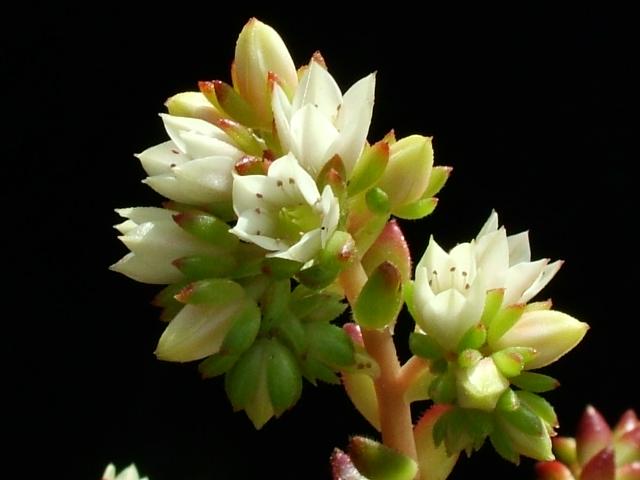

X Sedeveria LetiziaDescription of a cultivar new to cultivation by Jean-Michel Moullec with further comments by Ray Stephenson.Habit: evergreen perennial to 20 cm.Stems: many branching from the base, diameter 1·2 cm, with cilia, rosettes at the end. Young stem with leaves, no leaves on the old stems. Rosettes: diameter 6 cm, 22-50 leaves. Leaves: (1-)1·9 × 2·2 (-2·8) cm, obovate-cuneate with mucro, entire, ciliate on the margin and the keel, green, margin becoming red in the sun. Inflorescence: 1-3 cincinni with 5 or more flowers per cincinnus. Peduncle, pedicel and bract ciliate. Flower: 5-merous; sepals free, equal; petals united for 1-1·5 mm, light rose in bud, white but very light rose in the sun, carinate (with keel) 8 mm long, 3 mm broad; stamens short with filament white at the base, light rose near the anther, anther yellow-light brown; carpel green, style white. Parentage: Sedum cuspidatum X Echeveria setosa var. ciliata. Plant acquired from an Italian collection carrying the name X Sedeveria 'Letizia'. |
 Figure 1. X Sedeveria 'Letizia' in a 15 cm pot. |
About 25 years ago I purchased a single head of this plant from Brian Fearn of Abbey Brooke Cactus Nursery, Matlock, Derbyshire, England. It was clearly labelled Sedum cuspidatum X Echeveria setosa var. ciliata. I had both parents in those days and sadly lost the Sedum parent never to be able to recover it. Today my hybrid plant has only 4 heads. I have given away a few cuttings over the years but no one could describe this plant as vigorous!
I phoned Brian Fearn in June '05 to ask if he had ever named this plant. His nursery Abbey Brooke near Matlock, Derbyshire has been the source of many fine Crassulaceae cultivars, some of which Brian has named. Apparently he never did give this cultivar an epithet, so the name applied to the cultivar grown in Italy should be retained. He told me that he received his original cutting from Fred Wass, a Nottinghamshire miner, member of the NCSS (The National Cactus & Succulent Society) and keen grower of members of Crassulaceae. A number within his circle of acquaintances and friends such as Arthur Baynes, Victor Kane and Fred Ives, with whom he traded cuttings, have all had inter-generic Crassulaceae named in their memories.
Fred Wass too was obviously extremely keen to hybridise species in his collection, and Letizia is almost certainly a result of his horticultural experimentation. I have been trying to find out more about Fred Wass – (see page 45) where David Rushforth has given me some leads to follow up. Letizia was named for Letizia Alleruzzo.
 Figure 2. Terminal hirsute rosette of X Sedeveria 'Letizia' |
 Figure 3. Inflorescence of X Sedeveria 'Letizia'. Fig 1 and Fig 3 Ray Stevenson, Fig 2 Jean-Michel Moulec. |